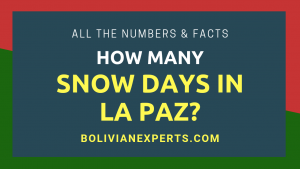There are many very cold places in Bolivia, but the coldest ones can vary according to some unique features they have, whether the place may be well-known, may have been visited for very specific purposes, or has recorded the lowest-ever temperature in the country. Also, some large cities can be really cold places in the country.
The coldest places in Bolivia are 1) the Los Andes’ scalable mountains, like the Huayna Potosí or Illimani, going below -22°F (-30°C) or less; 2) the Charaña town, with Bolivia’s lowest ever recorded temperature of -10.8°F (-23.8°C); 3) the Uyuni’s Salt Flat, with a lowest ever of -7.6°F (-22°C).
In this extensive overview of the coldest places in Bolivia, you’ll see which ones we consider really cold in our country, according to the historical factual data, our experiences, and also opinions while we have been living here and traveling across the country. You’re going to see the 7 coldest places in Bolivia.
Which is the coldest place in Bolivia?
If we want to see the coldest place in Bolivia by factual data then for sure it’s the Charaña town with the lowest ever recorded temperature in the country, of -10.8°F (-23,8°C) in 2010. Very close it would be the Uyuni’s Salt Flat, with the lowest ever recorded temperature of -7.6°F (-22°C) in 1946. But certainly, there are other places even colder within the country.
On way to see it is by differentiating the coldest place according to how you see them or their unique features, as follows:
- The coldest place ever recorded; Charaña town -10.8°F (-23,8°C) (Senamhi, 2010).
- The coldest tourist place; Uyuni’s Salt Flat -7.6°F (-22°C) (Senamhi, 1946). Usually below 15°F (-10°C) at night from May to August.
- The coldest Bolivian city; El Alto City, averaging 23°F (-5°C) at night from May to August, sometimes nights can go down to 10°F (-12°C).
- The coldest not confirmed place; the Bolivian mountains in the Los Andes mountain chain, like Huayna Potosí or Illimani, which can go down to -22°F (-30°C) or less.
- The coldest region of Bolivia; the Bolivian Altiplano, where there are located almost all the just mentioned places, with almost freezing temperatures from May to August and is on the eastern side of Bolivia.
As you can see, many very cold places in Bolivia may be important to you, but as we can say, whenever you are in the Bolivian Altiplano, in its tourist places, mountains, or cities you’ll feel very cold, particularly from April to August.
The top 7 coldest places in Bolivia
Now let’s see in detail according to our experiences, opinions, and the real data of Senamhi (the weather entity of Bolivia), which ones are the coldest places that exist inside the country.
You’ll see that almost all these places are located in the Bolivian Altiplano, a very flat and extensive region with a high elevation above 11,500ft (3,500m) on the western side of Bolivia.
1) Some outstanding mountains (very risky, for alpinism)
Bolivia is crossed by several large mountain ranges, where you can find many mountains and peaks that go above 20,000 ft amsl (6,000m). Then, many people that dedicate themselves to activities like mountaineering, trekking, or climbing will find these places very cold, with temperatures around 15°F to -25°F (-10°C to -30°C).
There are some mountains and peaks that are familiar and are often climbed:
- Huayna Potosí (relatively easy)
- Mururata (relatively easy)
- Illimani (difficult, deadly)
- Condoriri (difficult, deadly)
- Sajama (difficult)
- Chacaltaya (easy, by car)
- Many others
These peaks are located within the Altiplano of Bolivia, in the western part of the country.
Warning:
While some of these mountains are relatively easy to climb, some of them are very difficult and even deadly for experienced alpinists, as what happened many times in the Illimani mountain, where many foreigners died trying to climb it in the past (news on foreigner deaths: here, here and here)
You really need to know what you are doing if you wanna climb these mountains. Beyond the extreme cold that you can experience there, you need to take all the precautions, get the right tour guide and climbing agency in Bolivia, also to be well prepared to do these activities in these mountains.
2) Charaña town
Charaña is a small town located in one of the aridest and cold regions of Bolivia, in the southwest part of the country, where the endless flat Altiplanic lands are colder and many mountains and volcanoes reside, also it’s about 13,000 ft amsl (~4,000m).
This town is located in the La Paz department, on the border between Bolivia and Chile, and is very rustic, not friendly to tourists, as it doesn’t have any infrastructure to support them. It’s rarely visited by tourists.
The temperatures there are normally between 10°F and 5°F (-12°C -15°C), but these cold temperatures are only present between May and October of the year, the cold season in Bolivia, however from November to April, temperatures there are between 32°F and 50°F (0°C to 10°C).
This town is in the 2nd place as it has the special feature of having recorded the lowest ever temperature in Bolivia, of -10.8°F (-23,8°C), which happened in 2010.
3) Uyuni’s Salt Flat
The Uyuni’s Salt Flat is one of the most well-known and visited places in Bolivia, but it gets really cold, particularly between May and September (this is the cold season in Bolivia). During this time, temperatures there can be around 15°F to -5°F (-10°C to -20°C) at night, averaging water-freezing temperatures, but warmer during the day.
The lowest ever recorded temperature in the Uyuni’s Salt Flat was -7.6°F (-22°C) in 1946, very close to the lowest temperature ever recorded in the whole Bolivian territory, which happened in the Charaña town as we mentioned before.
So, this place gets very cold at the end of fall, the whole winter, and the beginning of spring in Bolivia, which happens between May and September. Remember to take the needed precautions when visiting this place, as it can get very cold, and always find the best tourist agency available to go there.
On the other hand, between October and April, the Uyuni’s Salt Flat is a lot warmer, averaging temperatures of 65°F (18°C) during the day and 35°F (2°C) at night.
4) All the towns and places in the southwest of Bolivia
This is part of the Bolivian Altiplano which is its coldest region, there, at the border between Bolivia and Chile in the Potosí department and part of the Oruro and La Paz departments is where is located the coldest region of Bolivia.
In this region, several towns and tourist places are very often visited by people from overseas, but also many towns never get visited by them (like the Charaña town) as they don’t offer too much to these people.
What is common in this region and all its towns, rural and urban areas is:
- An altitude of about 15,000ft amsl (4,500m).
- Freezing temperatures all year at night
- Very cold during the Bolivian cold season, from May to September, with temperatures between 40°F and 5°F (5°C and -15°C).
- In the Bolivian hot season from September to April, they can go up to between 60°F and 30°F (15°C and 0°C).
- Little annual precipitation of about 50mm to 250mm.
In this area of Bolivia you will find the following outstanding places:
- The Uyuni’s Salt Flat.
- The Charaña town.
- The Eduardo Avaroa National Park.
- The Coipasa’s Salt Flat.
- The Siloli and Dali deserts.
- The Red and Green Lagoons.
- The Sajama National Park.
- Many volcanoes and mountains above 18,000ft amsl (5,500m).
- Many small towns around.
5) El Alto City
We have been talking here about places that are not large cities in Bolivia, but large cities also can get very cold, particularly during the cold season in the country, which goes from May to August each year.
El Alto is the coldest city in Bolivia and the 5th coldest place in the country according to this list. It’s an important and very large city in the country, with about 1,089,000 people, being at 13,615ft amsl (4,150m), this is the main reason why it is so cold, also because it’s located inside the Bolivian Altiplano.
In the cold season, mostly between June and July, you’ll find that temperatures here can go down to 23°F (-5°C) at night, but some nights it can go down to 5°F (-15°C). During the day they can be around 60°F (15°C) they rarely go above 65°F (18°C). In the hot season, this city gets significantly warmer.
Then, whenever you are in El Alto city (which by the way is a dangerous city for tourists) between May and September, you’ll usually experience freezing temperatures at night and still will feel cold during the day, so you’ll need to use appropriate clothing to handle this situation.
6) Oruro City
Very close to El Alto city is Oruro city, with almost the same cold temperatures in the same season, both cities are very similar in their climatic and geographical features, which is why they show almost the same climatic behavior. Oruro is at an elevation of 12,254ft amsl (3,735m), and also is located within the Altiplano of Bolivia.
Oruro City is the 2nd coldest city in Bolivia and the 6th coldest place on this list. From May to September, this city normally gets a temperature of about 25°F (-4°C) at night, but on some nights it can go down to 10°F (-12°C). During the day, the city in this season gets warmer, with about 63°F (17°C), but it’ll rarely pass 68°F (20°C).
You don’t need to worry about really cold days during the Oruro carnival, as this festivity happens in February, which is within the hot season in the country (September to April). But between May and September, be sure to use the appropriate clothing to handle quite cold temperatures in the city, mostly at night.
7) Potosí City
Also very similar to El Alto and Oruro cities, it’s Potosí, a well-known tourist city of Bolivia, at an elevation of 13,418ft amsl (4,090m), with a population of 200,0000. Potosi has very similar geographical features to the other 2 cities mentioned before in this list, with the exception that it’s surrounded by big hills. This is why it’s also so cold during the cold season of the country.
Potosí, from May to August experiences temperatures of about 27°F (-3°C) at night, but some nights these can go down to 15°F (-10°C). During the day this city gets a lot warmer, with an average temperature of 64°F (18°C), almost never going above 68°F (20°C). From September to April, Potosí will be warmer, but still cold at night.
Whenever you are in Potosí between May and August, remember that during the nights, you’ll experience below-freezing temperatures, and during the day, you’re still going to feel very cold and will need to use the appropriate thick clothing.
Which are the coldest cities in Bolivia?
You have seen in this note that very large cities of Bolivia are also the coldest places to be in the country, but there are also other quite cold while bit warmer cities inside the country, including La Paz and sometimes Cochabamba.
In fact, the coldest cities in Bolivia are the following, from the coldest to the warmest:
- El Alto
- Oruro
- Potosí
- La Paz
- Cochabamba
- Sucre
- Tarija
The first 4 cities in the above list are very cold, while the 3 last ones are temperate but can get quite cold from May to September, with some nights reaching temperatures of about 35°F (2°C).
We have a complete guide about the coldest cities of Bolivia, with every detail about these cities in their coldest months, also the coldest city, in the following direction: The coldest cities of Bolivia, a complete overview.
Conclusions:
In this note about the coldest places of Bolivia, you’ve seen that both the Charaña town, followed very closely by the Uyuni’s Salt Flat, are the coldest official places in the country, with the lowest ever recorded temperatures of -22°C to -23.8°C (-7.6°F to 10.8°F) and average minimum temperatures of 15°F to -5°F (-10°C to -20°C) from May to August.
But also for climbers, trekkers, and alpinists the highly elevated mountains of the Los Andes mountain range, like the Huayna Potosí, Illimani, Sajama, Mururata and others will be a lot colder, as their peaks can go above 20,000ft amsl (6,000m) and their temperatures can go down to -22°F (-30°C) or less. These places are very dangerous and deadly, remember to only go if you know what you’re doing.
You also realized that the whole Bolivian Altiplano is a very cold place, in which all the coldest places on this list are located, including the El Alto, Oruro, and Potosí cities, but also the Charaña town, the Uyuni’s Salt Flat, the Eduardo Avaroa National Park, Sajama Park, the Green and Red Lagoons, and many towns around.
Finally, you learned that this flat highly elevated land, called Altiplano, located on the eastern side of the country, gets very cold between May and September, the cold season of Bolivia, but it gets a lot warmer between October and December.
We hope this information has helped you, and if you want to know every detail about the climate in Bolivia, including more information on the coldest locations in the country, visit our definitive guide in the following direction: How is the climate in Bolivia? A complete overview.
BolivianExperts.com, information about how to live, work, invest, and travel in Bolivia.








